by Judith Bruce
Most of us are very aware of and regularly get out and appreciate the wonders of nature in our saltwater environment: Watching the marshes change from the palest yellow-green to deep emerald from spring to summer then to an amazing gold in autumn; walking our incredible beaches in all seasons to observe the birds and other wildlife, listen to the crashing surf, watch the tides and changing shoreline; scan the waves for seals and sharks and peer out to the horizon to see a spouting whale; wonder at the hundreds of horseshoe crabs at waters edge in spring. These landscapes are ever changing and offer a near endless opportunity for entertainment.
But our freshwater ponds also offer an amazing array of sights and experiences to entertain and delight. Watching the painted turtles and snapping turtles lumber out of the water in June to find that perfect spot to dig a nest and lay eggs; watching the emerging plant life reappear in early summer; listening to the tree frogs and peepers herald the start of spring; and my favorite: the return of the wood ducks to my nesting boxes in late March and early April.
Wood ducks are amazing looking critters. The males are decked out in bright green, gold, blue and purple with red eyes and a crazy looking Napoleonic hat. The females are a bit more subdued in color but also have that crazy headpiece and a lovely white eye ring that gives them an exotic look. The ducklings are just plain cute little yellow puffballs.
Wood duck populations decreased a few decades ago due to hunting and loss of habitat. They use cavities in dead trees for their nests, but most people won’t tolerate a dead tree on their property. So with fewer places to nest, there were fewer woodies for us to enjoy. The good news is that many people have started putting up duck boxes. They can easily be placed in the water on a 4×4 post or attached to a very tall tree. If on a tree they like to be VERY high – like 30+ feet up – and are more vulnerable to raccoons and other predators. So when I started seeing wood ducks in trees at the edge of the pond (yes, they hang out up in trees or on the water), I put a duck box about 10 feet off shore. And it was immediately occupied!
Pretty soon there was another pair of wood ducks standing on the box trying to get in. But the female in the box was not willing to share. So I headed back to Birdwatcher’s General Store (Mike is happy to help!) and installed another box. Both of those boxes produced an adorable clutch of ducklings and the following spring, I added a third box. I’ve enjoyed watching babes hop out of all three boxes for almost 10 years now and it’s a rite of spring and summer I’ve come to look forward to each year. And I get the added benefit of over 20 wood ducks in my back yard each fall meeting and greeting to find mates for the following spring. They pair up in the fall and remain together through early summer.

Pairs of woodies begin to appear in late March and immediately start checking out the boxes to claim one for their nest. In late fall, I clean out the old nests and add clean wood shavings in anticipation of spring. The females go into the boxes in March and when they find a box they like, they pull out some of their belly feathers to mix with the wood shavings. This makes a soft, well-insulated, warm nest for their eggs and exposes more of their belly skin to provide more warmth to the eggs they are incubating.
While preparing the boxes, the hen will spend about half an hour in the box in the morning while the male or drake waits at the base of the box slowly swimming around the pole. They fly off together only to return the following morning for the hen to begin laying eggs. They will arrive at the box the same time every morning and she will lay an egg a day until she has a full clutch of 8-15 eggs. It takes her about an hour to lay an egg and the drake will remain close to the box the entire time. One of the few times one can have a predictable, near guaranteed wildlife sighting!
Once she has her full clutch, she will remain on the nest incubating the eggs, leaving the box only twice a day – morning and night at the same time every day –for about an hour. The drakes usually take off at this point to join other “guys” not returning until the fall meet and greet. But there is one drake who has come each year who religiously returns every morning and evening to accompany his hen out of the box for her incubation breaks. 28 to 33 days after she begins incubating, the ducklings will hatch. They remain in the box for only the day they are hatching. The next morning, Mama duck hops out of the box into the water between 7 and 8 AM and quietly calls to them.
Like popcorn, they begin hopping out of the box into the water. Within a few minutes they are all out and form a circle of ducklings in the water. She swims them off to a hidden location in the reeds and they are rarely seen again despite the fact that they will remain on the pond for several weeks until they can fly. For the first year of life, little woodies eat bugs, tadpoles or little fish if they can catch them and any other form of protein available. Once grown, their diet changes to pond weeds and a favorite – acorns! As ducklings or adults, they are extremely shy and do not like people so if you wish to attract them, you need to willing to stay away from their boxes from March through June (or until they have fledged).
Even if you don’t see wood ducks, our fresh water ponds are home to dozens of species of ducks each fall and winter: black ducks, mallards, Buffleheads, mergansers, ring necks, pied billed grebes, golden eyes, teals – even the occasional common or Red-throated loon in the spring. For those of us with failing eyesight, it’s a lot easier to watch for and identify a duck than a warbler! And most of our ponds host a large assortment of herons and songbirds as well as large and small mammals looking for food and water.
So this winter and spring head to a fresh water pond to check out all the wonders of nature these water bodies provide. Yet another reason to give thanks to be living in this magical, wonderful world of water!
Got a Pond Story you want to share? Email Kristin Andres [email protected]
Pond Stories are a collection of writings from Cape Codders and visitors who love the 1000 local ponds that dot the Cape. We hope this collection of stories, that are as much endearing as they are environmentally aware, will awaken your inner environmentalist to think deeper about our human impacts to these unique bodies of water. Check out these valuable resources to learn more about the current challenges Cape Cod ponds are facing and how you can be a better pond steward in your town.


